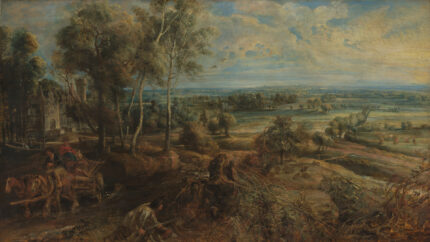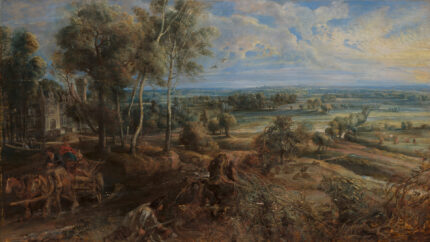London’s National Gallery has cleaned and conserved one of their greatest works by Flemish Baroque master Peter Paul Rubens. View of Het Steen in the Early Morning was dingy and yellowed from discolored varnishes applied by restorers 75 years ago.
Rubens’ commissions were mostly portraits of aristocrats, altarpieces and large-scale historical, Biblical and mythological scenes, but he was also an art collector in his own right and a dedicated student of architecture. His townhouse in Antwerp, now known as the Rubenshuis, was extensively renovated and rebuilt based on his designs for both the exteriors and interiors.
His classical humanist education served him in good stead throughout his career, advancing him socially and professionally above the rank most artists, who no matter how elevated their clientele ultimately worked with their hands, were able to achieve. Habsburg patrons deployed Rubens on diplomatic missions when he travelled to other courts for art commissions. He was held in high esteem for his talents as an artist and as a diplomat, and was knighted by Philip IV of Spain in 1624 and Charles I of England in 1630.
In 1635, Rubens bought the Elewijt Castle, also known as the Castle of Het Steen, in the village of Elewijt 20 miles south of Antwerp. His acquisition of a landed estate was symbolic of his rise in status from artist to courtier and gentleman and he put brush to panel to capture his new demesne. He depicted his manor house and the bustle of activity — ox cart going to market, hunter and dog stalking birds — of a country estate shortly after dawn.
By then his phalanx of students at the workshop in the Rubenshuis had been executing commissions for more than two decades, all designed, overseen and finished by the master, but most of the hands-on work was being done by his employees. A View of Het Steen in the Early Morning is 7.5 feet wide and 4.2 feet high and all of it was painted by Rubens himself, probably to decorate one of the grand rooms of the Het Steen. And thus the artist became his own patron.
The discolored varnishes dramatically altered the Rubens palette, yellowing everything and eliminating the delicate warm gold accents from the sun against the white of the clouds. The contrast of the earth tones in the foreground against increasingly cool blues going backwards in the landscape was flattened as well. Now that it has been cleaned and the old varnish removed, Rubens’ original vision shines through.


A fantastic painting but I do not see an ox cart. I see a two horse pulled wagon with a hog-tied calf between the driver and the female passenger. I cannot make out what the group of worsen near the house are doing.
Yeah, those oxen are definitely horses. What you also can see in the distance is the tower of Antwerp cathedral — cf.:
Cathedral_of_Our_Lady_(Antwerp)
Merry Christmas to you all (with at least the music video from Antwerp), and of course sung in Greek about Christmas:
youtube.com/watch?v=e7c-L_WbdTg
————————————-
Σήμερον γεννᾶται ἐκ Παρθένου,
ὁ δρακὶ τὴν πᾶσαν ἔχων κτίσιν (τρις)
Ῥάκει καθάπερ βροτὸς σπαργανοῦται,
ὁ τῇ οὐσίᾳ ἀναφής.
Θεὸς ἐν φάτνῃ ἀνακλίνεται,
ὁ στερεώσας τοὺς οὐρανούς πάλαι κατ’ ἀρχάς.
Ἐκ μαζῶν γάλα τρέφεται,
ὁ ἐν τῇ ἐρήμῳ Μάννα ὀμβρίσας τῷ Λαῷ.
Μάγους προσκαλεῖται,
ὁ Νυμφίος τῆς Ἐκκλησίας.
Δῶρα τούτων αἴρει,
ὁ Υἱὸς τῆς Παρθένου.
Προσκυνοῦμέν σου τὴν Γένναν Χριστέ (τρις)
Δεῖξον ἡμῖν καὶ τὰ θεῖά σου Θεοφάνεια.
The castle that is depicted here is the one at 50°57′33.63″N 4°28′38.76″E – 10km north of Brussels, west of the Autobahn from Brussels to Antwerp.
Directly in Antwerp, however, there is another castle, likewise referred to as “Het Steen” (the stone), but that is, as mentioned, the city center close to the river.
The tower looks, when driving on the Autobahn to Zeeland in NL, i.e. north of Antwerp, still exactly as depicted in the painting, with more concrete around it, of course.
Early recorded versions of the name include ‘Ando Verpia’ on Roman coins found in the city center, and there was a ‘vicus’. Germanic ‘Andhunerbo’ from around the time of Austrasia became a separate kingdom (that is, about 567 CE).
Turns out, there was a highway –or system of highways– in Elewijt village back in Roman times too (cf.: “Elewijt vicus”), and at least in some cases those were even pre-Roman pathways.
perseus.tufts.edu/hopper/text?doc=Perseus:text:1999.04.0006:entry=elewijt
———–
“Gallo-Roman vicus N of the civitas Nerviorum on the Namur-Baudecet-Rumst road. It is on the boundary between the sandy Campine province and the more fertile Brabant, at the spot called Zwijnbeer, a hill to the N of the modern village. Excavations show that the vicus covered an area of some 27 ha. Important finds of Roman antiquity have been made since the 17th c. and many amateurs have carried out scattered excavations. An undisturbed section of the vicus was systematically excavated in 1947-53.
There were three periods of occupation. The earliest clue is the mark of a rectilinear ditch, which has been traced over 60 m. Its profile is V-shaped, as is characteristic of Roman camps. This camp (Augustan?) was just a temporary one, and the ditch was very soon filled in. The vicus started to grow during the reign of Claudius when a large part of the road network of N Gallia was built. At that time Elewijt was linked by road to the vicus of Asse and also to Bavai. […]
Toward the end of the 2d c. the settlement was almost completely destroyed. It was rebuilt on an entirely different plan: thereafter the houses were oriented on a NW-SE axis. A large building, erected in the middle of the vicus, had several rooms, heated by hypocaust and walls decorated with friezes. […] It may be that it was ravaged during the invasions of the second half of the 3d c. In any case there are few traces of the 4th c. In the 19th c. the necropolis of the vicus was located at the section called Heidendries, but little is known about it.”
———–
This is not Antwerp Cathedral, in between lies the city of Mechelen.
But i don’t think this is a view in the early morning. The view of the castle is to the south (you can check that on google Maps), so it would be evening, and the city in the back should be Vilvoorde.
Hi Steemans Guy,
Its been a while since I was in the area, and particularly it was the shape of the tower that convinced me of Antwerp (and still it does). Occasionally, I messed with ‘Mechelen’ and ‘Machelen’, and I know Diegem, but I am not familiar with any towers in Volvoorde.
On the other hand, I must say that you certainly have a point with Mechelen, but to the best of my knowledge the tower in Mechelen looks completely different to the one in Antwerp. Does any tower in Vilvoorde, therefore, look like the one in Antwerp?
The artist’s links to Antwerp are certainly closer than any relations that he might have had towards Vilvoorde and Brussels, I am guessing. Often, I took the Autobahn from Brussels to Antwerp, but I did not notice Vilvoorde nor Mechelen (actually it is an ‘S’ with a slope around both destinations).
Thanks for the feedback.
———
PS: I so far checked on OSM, but I will also have a Streetview with Google. The tower, in case the view is to the south , might in fact be the one in ‘Grote Markt‘ in Brussels. Any opinions on that?
—————
“Er lag Rubens en zijn tijdgenoten weinig aan de weergave van de realiteit. Rubens creëerde zijn eigen Brabantse land, zoals hij dat wilde zien. Hij gaf de weelderige natuur een plaats, de sluipende jager en de boeren met paard en volgeladen kar als verhalende elementen. […]Rubens ontving, voor zover bekend, zeer weinig bestellingen voor landschappen.[…]
Na bijna vierhonderd jaar kan men topografisch nog veel herkennen in dit herfstlandschap. Onder meer het houten bruggetje over de plaatselijke Barebeek in Elewijt en de fel meanderende Zenne tussen Eppegem en Weerde. De geometrie van dit alles is niet correct maar aan de horizon zouden de contouren van Mechelen moeten te zien zijn. Anderen beweren bij hoog en bij laag dat hij in zijn kasteel alleen maar aan zijn Antwerpen kan hebben gedacht.”
—————
According to this (i.e. nl.wiki/Herfstlandschap met uitzicht op_het_Steen), both aspects might be valid. The waterstream in the right side of the painting, however, would rather be the Leibeek and not the Zenne. In ‘realiteit’ he, therefore, simply seems to have omitted a full picture of Machelen –sorry– Mechelen, of course. Dürer describes in his diaries his route from Antwerp to Brussels and back, and if I remember correctly, indeed mentions Machelen (or Mechelen?).
Would the distance rather be 10km or 20km, and would you smell the North Sea behind whatever city there is depicted?
Personally I think I would, and I’d reckon it’s rather 20k. Note, however, that this could all be Dutch to me 😉
————–
upload.wikimedia.org/wikipedia/commons/7/78/Peter_Paul_Rubens_-_A_View_of_Het_Steen_in_the_Early_Morning.jpg
That he would only take Antwerp in consideration as a city in the background is incorrect. There is a painting in the Palazzo Pitti in Florence where the city of Mechelen is clearly visible in the background. The distance from the Castle to Antwerp is 35 k, to Mechelen 10 k, and to Vilvoorde only 5 k. We should also take in consideration that the skyline of these cities has changed in the past 400 years. Looking at the orientation of the castle on the painting it should be Vilvoorde, but artistic freedom is possible.
Belgian painters have left a rich legacy of masterpieces for posterity. A mere one life may not be enough to savor all their unique creations one finds in their cathedrals, basilicas, churches, chapels, monasteries, city and university halls, libraries, Begijnhofs and museums across Flanders and Wallonia. Brussels, Aalst, Ghent, Bruges, Antwerp, Malines, Leuven, Namur, Liege, Eupen and even in smaller towns, there is much to see, appreciate and remember. It’s a unique country of great and many painters.
…yeah, but with the exception that “Belgium” was just about to be invented, and of course the painters from the “Low Countries” are a few more 😉